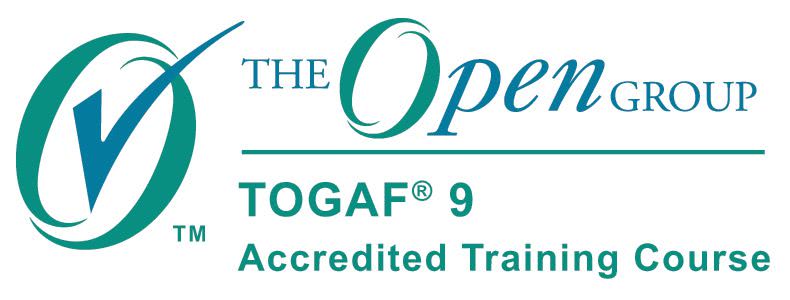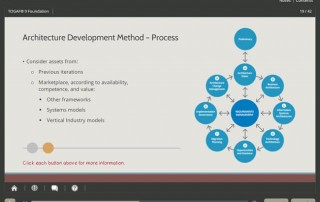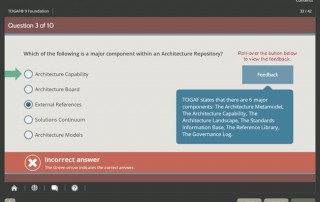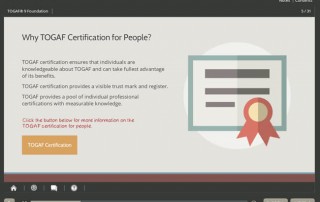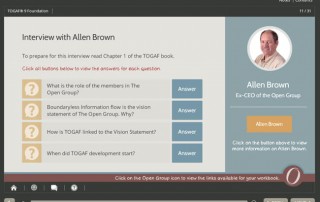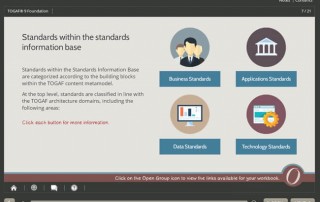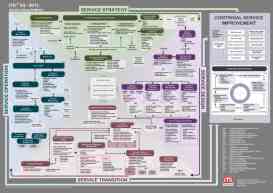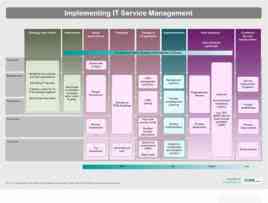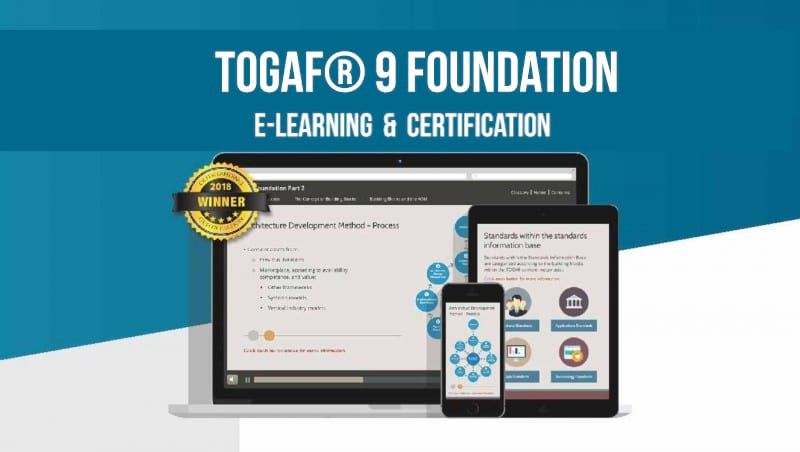
TOGAF 9 edukacija i certifikacija
TOGAF 9 Foundation
This course has been fully accredited by The Open Group and meets all the learning requirements of the latest version of TOGAF in order for students to sit and pass the TOGAF Foundation level exam.
Key information about this course:
Price: 619 € + VAT
E-learning Level 1 (400 €) + Exam Voucher Level 1 (219€) + VAT
- 10 hours of course material included
- Fully accredited by The Open Group
- Includes revision modules, practice exams, and 24/7 tutor support
- Downloadable PDF Workbook
- Quizzes and revision modules
- Mock exam simulator with answers
- Award winning TOGAF training
This course comprises training material, reflecting Version 9.2 of the TOGAF 9 Standard and is built around a core of interactive slides, video and audio narration. The course is self-paced, allowing the student to pause and continue their learning at their own convenience. Each module concludes with a quiz allowing students to check their understanding at key moments in the course. Any module may be revisited at any time.
TOGAF provides an iterative approach to development at four levels of architecture: Business, Application, Data, and Technology.
The Architecture Development Method (ADM) is the keystone of the framework and is covered extensively in this course with interactive guides, quizzes, and videos.
This TOGAF 9 Foundation e-Learning course has been accredited by The Open Group and will give you a good knowledge of the TOGAF 9 standard.
With this course, you’ll receive 6 months access from the date of purchase.
Optionally you can purchase an exam voucher to use whenever you are ready to sit the TOGAF Level 1 exam.
TOGAF® 9 Foundation delivered by Good e-learning is a course accredited by The Open Group. ITS Partner promotes this course for Good e-Learning.
- The TOGAF® Standard, version 9.2 Foundation Workbook
- Why TOGAF Certification for People?
- The TOGAF Certification Program
- Enterprise Architecture Background
- Interview with Allen Brown – CEO of the Open Group
- Architecture in the TOGAF Context?
- TOGAF Background
- Architecture Types
- TOGAF 9 Components
- What is the Value of TOGAF as an Architecture Framework
- What is an Architecture Framework?
- TOGAF Components
- Describe the main objectives of each phase
- Briefly explain the approach undertaken for each phase
- Briefly explain how Requirements Management fits into the ADM cycle
- Describe the nature of the Requirements Management process
- To briefly explain the contents of Part III of TOGAF 9
- The need for Architecture Principles and where they are used within TOGAF
- The standard template for Architecture Principles and what makes a good Architecture Principle
- What a Business Scenario is, its purpose, and explain where Business Scenarios are used within the ADM cycle
- The purpose of Gap Analysis and describe the Gap Analysis technique
- Explain the term interoperability, and understand the use of Interoperability Requirements within the TOGAF ADM
- To understand the Business Transformation Readiness program and where Business Transformation Readiness is used within the ADM
- To understand the characteristics of Risk Management and where Risk Management is used within the TOGAF ADM and to understand Capability-Based Planning
- To define and explain the concepts of Stakeholders, Concerns, Architecture Views, and Architecture Viewpoints
- To describe a simple example of an architecture viewpoint and view
- To discuss the relationship between stakeholders, concerns, architecture views, and architecture viewpoints
- To describe the architecture view creation process
- To define what a building block is, and explain what makes a good building block
- To explain the distinction between Architecture Building Blocks and Solution Building Blocks
- To explain the use of building blocks in the ADM cycle
- To describe the characteristics of an Architecture Pattern
- To explain the role of architecture deliverables across the ADM cycle
- To briefly explain the purpose of key TOGAF deliverables such as Architecture Building Blocks, Architecture Contract, Architecture Principles, Architecture Vision, Compliance Assessment, or Statement of Architecture Work
- To explain what the Enterprise Continuum is
- Describe how it is used in organizing and developing an architecture
- To explain how the Enterprise Continuum promotes re-use of architecture artifacts
- Describe the constituents of the Enterprise Continuum
- To explain the purpose of the Enterprise Continuum
- To explain the purpose of the Architecture Continuum
- To list the stages of architecture evolution defined in the Architecture Continuum
- To explain the purpose of the Solutions Continuum
- To list the stages of architecture evolution defined in the Solutions Continuum
- To explain the relationship between the Enterprise Continuum and the TOGAF ADM
- To describe the Architecture Repository, and explain the relationship between the Enterprise Continuum and the Architecture Repository
- To describe the classes of information held in the Architecture Repository
- To list the three levels of the Architecture Landscape
- To explain the purpose of the Standards Information Base within the Architecture Repository
- To explain the role of the TRM as a Foundation Architecture
- To describe at a high-level the main components of the TOGAF TRM
- To explain the basic concepts of the III-RM
- To explain the relationship of the III-RM to the concept of Boundaryless Information Flow
- To explain the concept of Architecture Governance and explain why it is beneficial
- To describe the main components that make up an Architecture Governance framework
- To explain the need for establishment of an Architecture Board and list its responsibilities
- To explain the role of Architecture Contracts
- To explain the meaning of and need for Architecture Compliance
- To explain the purpose of Architecture Compliance Reviews and briefly describe the Architecture Compliance Review process
- To explain how the ADM can be used to establish an Architecture Capability
What you need to know about the exam:
- This is a multiple choice exam consisting of 40 questions.
- There is a time limit of 60 minutes to complete the exam
- The exam is closed book – you cannot make use of any resources or materials during the exam
- To pass the exam you must get 22 out of 40 questions correct (55%)
- In countries where English is a second language, the time allocated for the exam is extended to 90 minutes
Pearson Vue are the authorized providers of exams for TOGAF, IT4IT and ArchiMate certification, and host exams worldwide through a network of test centers. We can provide you with a voucher for the Foundation level exam on request.
The exam voucher is valid for 12 months from the date of issue.
TOGAF 9.2 Foundation course features a student workbook, available as a PDF download. The student can use this workbook to make notes as they progress through the course. A completed workbook makes a great resource for exam preparation.
Either print out the workbook and make hand-written entries, or (if you have Adobe Reader 11 or later) make notes directly into the PDF.
Each module concludes with a number of multiple choice questions that cover the information you have just engaged with. Use these opportunities to test your understanding and recall of the topics as you progress. Revisit the module until you are comfortable in answering the questions correctly. You can then move on to the next module with confidence.
One mock exam and mock exam simulator with answers is included within the course to prepare students to take the official exam as best possible.

